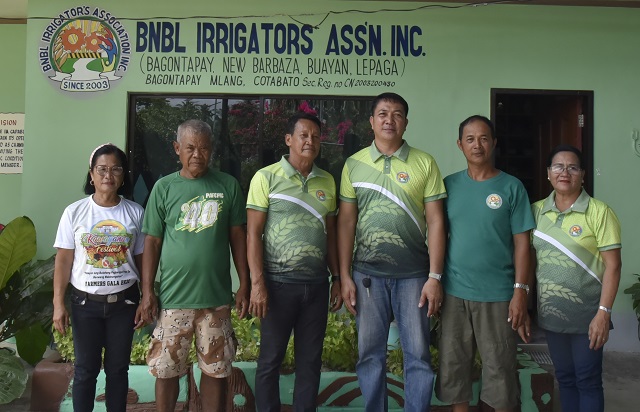
Nightmares of drought are still vivid in the mind of Nestor Mendoza. At midnight, they are wide awake, watching their fellow farmers from the downstream of the M’lang and Malasila Rivers Irrigation System (MMRIS) march up to avail of their right to farm water, even in darkness.
“When rain is elusive, water supply is not enough for those who are at the tail end of the irrigation,” this member from the midstream recalled.
Mendoza, a 63-year-old farmer-member of the Bagontapay, New Barbaza, Buayan, Lepaga (BNBL) Irrigators’ Association (IA) in North Cotabato witnessed how conflicts arose every time downstream fields couldn’t get sufficient water. He heard every farmer’s sometimes – wayward assumption about the situation.
For Angelita Necesito, 59, the case was most unbearable during the 1982-1983 El Niño episode.
“Gamay lang siya (It was little),” she described the amount of water flowing to her field. “The water would go to the large cracks in the soil. I had to ‘guide’ the water so that it would go directly to the rice plant.”
Her 1.5ha field could only produce 1.74t/ha under such condition.
Knowledge flowed
In 2009, the alternate wetting and drying (AWD) technology was introduced by the National Irrigation Administration (NIA) and PhilRice to the member-IAs of MMRIS. Mendoza, Necesito, and other farmers never thought this would lead them to better days.
AWD is a water-saving technology that can help reduce the consumption of irrigation water without reducing rice yield. It is done with the aid of an observation well, used to monitor changes in groundwater levels.
After receiving training, IA leader Mendoza shared his knowledge to other farmers through their monthly meetings.
Roger Celeste, current President of BNBL IA, became an AWD consultant to farmers after completing training.
“Before, we were having a hard time educating them about the technology but now we could see their willingness. They approach us immediately when we put observation wells in the field,” Celeste narrated.
It is through the meetings that Jesus Panes Jr., 63, of DLS IA extended his knowledge to his fellow farmers. He also served as AWD lecturer in Sultan Kudarat and South Cotabato.
Gilda Reovoca, member of the BIMADU IA – another group serviced by the MMRIS – said their former president, Manuel Aliaga, was the first and lone farmercooperator who used AWD during that time.
Reovoca said Aliaga eagerly shared his AWD experience with them. The members were encouraged to try, but for Reovoca, their obedience was not solely because of the knowledge. It was the credibility of Aliaga that further motivated them to follow.
In 2013, more members of the BIMADU IA also participated in the PhilRice Midsayap-led training courses and pilot demonstration activities on AWD and other associated technologies.
Their federation, the Kapisanan ng mga IA ng MMRIS, also passed the ‘One Farmer, One Tube Well’ policy, and organized the ‘Best Demonstration Farm’ contest to give more weight to the initiative.
Quenching results
The participating Cotabato farmers found satisfaction from their obedience and commitment. It did not just mitigate the negative effects of water shortage, but it also helped them increase their yield by 20%.
“If you practice AWD, the rice plant could produce more tillers that would lead to better yield. If we often flood our rice field with water, it could be easily attacked by different pests,” Reovoca explained.
Members of the BNBL IA had their average yields soaring to 9.1t/ha during the dry season and 10.4t/ha during the wet season.
More than the tangible effects, the most valuable impact of the technology on them was the harmonious relationship they now enjoy. MMRIS succeeded in irrigating 100% of its service area.
“Today, farmers are kinder and more generous to each other. If they see in their observation well that they still have enough water, they would let the water flow to other rice fields,” Celeste attested.
Looming waves
MMRIS, which can irrigate 8,000ha of rice fields, is currently close to reaching its 310-cm critical water level because of lack of rainfall.
NIA has mobilized vehicles announcing the forecasts on the unwelcome El Niño phenomenon. They roam around the farmers’ vicinities, informing them to begin their land preparation so that managing the water won’t be as difficult as they expect it to be in the upcoming months. Drought might once again befall the lands of Cotabato farmers.
But this time, they’ll tread in each other’s rice fields, no longer brimming with frustrations and negative assumptions toward each other. They will now face the problem with a 25-cm observation well and a handful of water-saving technologies installed in their hearts.




